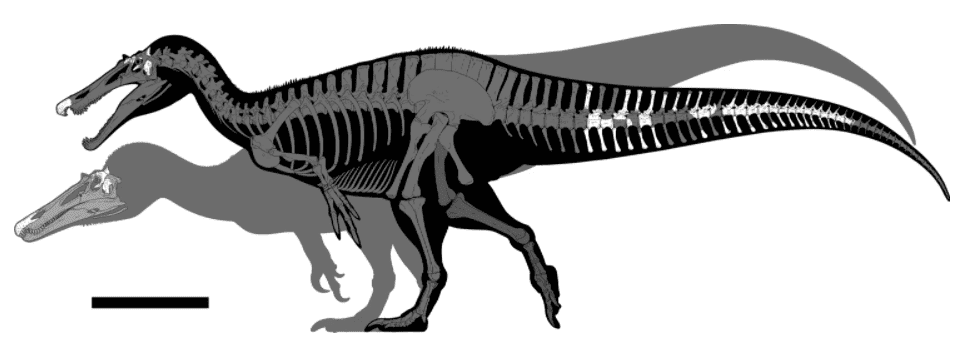Researchers at the University of Southampton have described two new species of spinosaurid, a group of predatory dinosaurs, on the Isle of Wight.

The two dinosaurs belong to the theropod family and are close relatives of the distinctive Spinosaurus. Judging by the crocodile-like shape of their skull, these animals hunted prey on both land and water, the team explained. The species were described based on fossilized bones unearthed near Brighstone over several years. These included parts of two skulls and a large tail section. Overall, 50 different bones from the site have been unearthed from rocks in the 125-million-year-old Wessex Formation.
Apart from these two, only one other species of spinosaurid has previously been unearthed in the UK, the Baryonyx. Virtually all other findings consisted of isolated teeth or bones.
Crocodinos
“We found the skulls to differ not only from Baryonyx, but also one another, suggesting the UK housed a greater diversity of spinosaurids than previously thought,” explains Chris Barker, a PhD student at the University of Southampton and lead author of the study.
“It might sound odd to have two similar and closely related carnivores in an ecosystem, but this is actually very common for both dinosaurs and numerous living ecosystems,” said Dr David Hone, co-author from Queen Mary University of London.
After analyzing the fossils at the University of Southampton, the authors determined that they didn’t belong to any previously identified species.
Following this, one specimen has been christened Ceratosuchops inferodios, roughly translating to “horned crocodile-faced hell heron”. This species is characterized by a series of short horns and bumps growing around the animal’s brow. The name was owed to its likely hunting style, which would be similar to that of a heron, which catches aquatic prey by lurking around the edges of waterways. At the same time, the diet of herons is much more flexible than most people would assume, and often includes terrestrial prey.
The other specimen was named Riparovenator milnerae, translating to “Milner’s riverbank hunter”. This name was given in honor of British paleontologist Angela Milner, who recently passed away. Dr. Milner was the one to study and name Baryonyx.
With the caveat that the skeletons are incomplete, so we can’t know for sure, the researchers estimate that both dinosaurs grew to around nine meters in length, and their skulls would grow to around a meter in length. Based on these fossils, the authors propose that spinosaurids likely evolved in Europe and then dispersed into Asia, Africa, and South America.
The rocks on the Isle of Wight where these fossils were found formed in an ancient floodplain environment in a Mediterranean climate. Remnants of forest fires can be seen as dark bands throughout the cliffs even up to today. However, at the time, this environment provided ample hunting opportunities consisting of fish, sharks, and crocodiles in various bodies of water.
“On behalf of the museum, I wish to express our gratitude to the collectors, including colleagues at the museum, who have made these amazing finds, and made them available for scientific research. We also congratulate the team who have worked on these exciting finds and brought them to publication” said Dr Martin Munt, Curator of Dinosaur Isle Museum.
The new fossils will go on display at Dinosaur Isle Museum at Sandown.
The paper “New spinosaurids from the Wessex Formation (Early Cretaceous, UK) and the European origins of Spinosauridae” has been published in the journal Scientific Reports.


